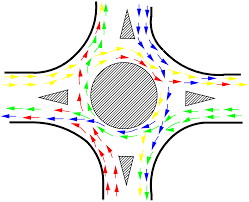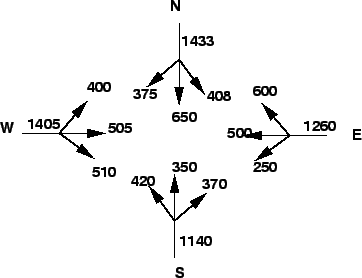Rotaries - Overview | Civil Engineering Optional Notes for UPSC PDF Download
I. Introduction to Rotary Intersections
- Rotary intersections, also known as roundabouts, are a special form of at-grade intersections designed for the movement of traffic in one direction around a central traffic island.
- They convert major conflicts (such as collisions between through and right-turn movements) into milder conflicts (merging and diverging).
- Vehicles entering the rotary are gently forced to move in a clockwise direction and then weave out to the desired direction.
II. Advantages of Rotary Intersections
- Traffic flow is regulated to only one direction, eliminating severe conflicts between crossing movements.
- Vehicles are forced to reduce speed and continue moving at slower speeds, eliminating the need for complete stops.
- Lower negotiation speeds and elimination of severe conflicts lead to fewer accidents and reduced severity.
- Rotaries are self-governing and do not require police control or traffic signals.
- Suitable for moderate traffic, irregular geometry, or intersections with more than three or four approaches.
III. Disadvantages of Rotary Intersections
All vehicles are forced to slow down and negotiate the intersection, leading to higher cumulative delays.
Vehicles are forced to reduce speed even when traffic is relatively low.
Rotaries require a large area of relatively flat land, making them costly in urban areas.
Not suitable when there is high pedestrian movement, as vehicles do not typically stop and exit at relatively high speeds.
IV. Guidelines for Selecting Rotaries
- Suitable when traffic entering from all approaches is relatively equal.
- Total volume between 500 and 3000 vehicles per hour is recommended.
- Beneficial when the proportion of right-turn traffic is high (typically more than 30%).
- Suitable for intersections with more than four approaches or when separate right-turn lanes are not available.
- Ideal for complex intersection geometries.
V. Traffic Operations in a Rotary
Three main operations: diverging, merging, and weaving.
Diverging: Separating vehicles moving in one direction into different streams based on destinations.
Merging: Joining traffic from different approaches and going to a common destination into a single stream.
Weaving: Combined movement of merging and diverging in the same direction.
VI. Design Elements
A. Design Speed
- Lower design speeds (30-40 km/h) are used for rotaries compared to the approach roads.
- Lower speeds reduce the required size and construction cost. B. Entry, Exit, and Island Radius
- Entry radius (20-25 m) forces speed reduction through curvature.
- Exit radius should be 1.5-2 times the entry radius for efficient discharge.
- Central island radius is typically 1.3 times the entry radius to prioritize circulating traffic. C. Width
- Entry and exit widths are lower than the approach road widths for speed reduction.
- Weaving width is one lane more than the average entry and exit width for smoother merging and diverging.
- Weaving length determines the smoothness of merging and diverging, with a minimum ratio of 4 to the weaving width recommended.

Traffic Operations in a Rotary
Width Considerations
Entry and Exit Width
The entry and exit widths are governed by the traffic entering/leaving the intersection and the width of the approaching road.
To enable speed reduction, the carriageway width at entry and exit is kept lower than the width of the carriageway at approaches.
Indian Roads Congress (IRC) Guidelines:
For a two-lane road of 7 m width:
Urban roads: Entry/exit width = 7 m
Rural roads: Entry/exit width = 6.5 mFor a three-lane road of 10.5 m width:
Urban roads: Entry/exit width reduced to 7 m
Rural roads: Entry/exit width reduced to 7.5 m
Weaving Width
The weaving width should be higher than the entry and exit widths to facilitate smoother merging and diverging.
It is typically one lane more than the average of the entry and exit widths.
The weaving width (w_weaving) is given by:
w_weaving = (e_1 + e_2)/2 + 3.5 m (1)
Where:
- e_1 is the carriageway width at entry
- e_2 is the carriageway width at exit
Weaving Length
- The weaving length determines how smoothly the traffic can merge and diverge.
- It is decided based on factors like weaving width and the proportion of weaving traffic to non-weaving traffic.
- A higher ratio of weaving length to weaving width is desirable for smoother operations.
- IRC suggests a minimum ratio of 4 for the weaving length to weaving width.
- However, an excessively large weaving length may encourage over-speeding and should be avoided.
Capacity
The capacity of a rotary is determined by the capacity of each weaving section.Transportation Road Research Lab (TRL) Empirical Formula:
The TRL proposed the following empirical formula to find the capacity of the weaving section (Q_w):
Q_w = 280 * w * (1 + e/w) * (1 - p/3) / (1 + w/l) (2)
Where:
w is the weaving width
e is the average of entry and exit widths = (e_1 + e_2)/2
l is the length of the weaving section
p is the proportion of weaving traffic to non-weaving traffic
The formula is valid under certain conditions:
- Weaving width between 6 and 18 meters
- Ratio of average entry/exit width to weaving width between 0.4 and 1
- Ratio of weaving width to weaving length between 0.12 and 0.4
- Proportion of weaving traffic to non-weaving traffic between 0.4 and 1
- Weaving length between 18 and 90 meters

Weaving Operation in a Rotary
The weaving section displays four types of movements, with a and d representing non-weaving traffic, while b and c denote weaving traffic.
Therefore,

Example: The width of a carriage way approaching an intersection is given as 15 m. The entry and exit width at the rotary is 10 m. The traffic approaching the intersection from the four sides is shown in the figure 4 below.

Traffic Approaching Rotary
Find the capacity of the rotary using the given data.
Solution:

The traffic from the four approaches negotiating through the roundabout is illustrated above.
Weaving width is calculated as, 
Weaving length, I is calculated as = 4xw = 54 m
- The proportion of weaving traffic to the non-weaving traffic in all the four approaches is found out first.
- It is clear from equation,that the highest proportion of weaving traffic to non-weaving traffic will give the minimum capacity. Let the proportion of weaving
- traffic to the non-weaving traffic in West-North direction be denoted as pvvx, in North-East direction as I)NE, in the East-South direction as Es, and finally
- in the South-West direction as psw.
- The weaving traffic movements in the East-South direction is shown in figure below.


Traffic Weaving in East South Direction

|
350 videos|464 docs|2 tests
|

























